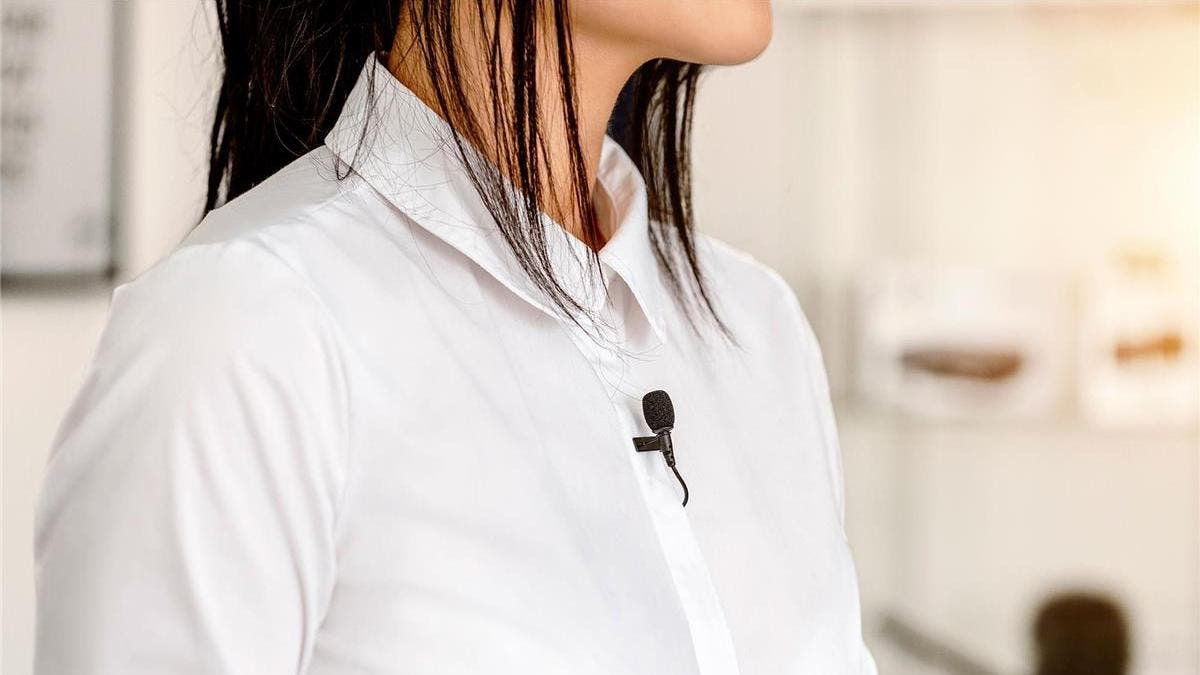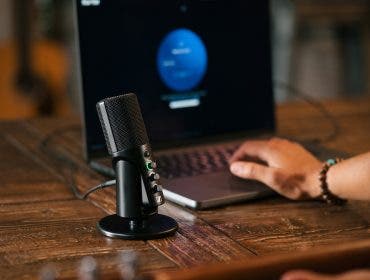Getting clean sound from your subject when recording is extremely important no matter what type of recording you are working on — be it film, television, event work, such as wedding videography or corporate videography. There are several different methods of getting excellent sound recordings. One common way is to have a microphone, often either a shotgun or condenser microphone placed on a boom pole. Another common method for recording sound is to use a lavalier microphone which allows your subject to move freely without the worry of having an operator that can accidentally be seen in your frame.
What is a Lavalier Mic?
A lavalier microphone is a very small (about the size of a fingernail) lightweight microphone that is typically worn on a person’s clothing, attached to their skin, or attached to an object for capturing audio. Also known as a lapel mic, clip-on mic, or body mic, it is commonly used to give actors freedom of movement. In many situations, it is used in coordination with a boomed microphone for dual system sync sound.
Lavaliers are omnidirectional or directional condenser microphones. They are preferred when you are looking for an unobtrusive way to record sound. These mics allow for natural movement and hands-free use. Some lavalier microphones feature a cardioid polar pattern to minimize background noise and improve clarity by focusing on the sound source in front of the mic. They can be used in both wired and wireless configurations, with wireless options utilizing radio frequency (RF) or infrared (IR) transmission.
Wired vs Wireless Lavalier Mics
Wired lavalier microphones are connected to the audio recording device using a cable — most commonly a 3-pin XLR, mini-jack, USB, or 3.5mm jack. The benefit of using a wired lavalier mic is they are generally more reliable and provide a higher quality audio signal since there is no risk of interference or signal dropout. However, the fact that the cable is directly attached between your talent and the audio recording device limits the mobility of the person wearing the microphone.
Wireless lavalier microphones, on the other hand, use a transmitter to send the audio signal wirelessly to a receiver, which is connected to the recording device. This provides greater freedom of movement for the person wearing the microphone. Although, tt can be affected by interference from other wireless devices and may require additional setup time to ensure a stable connection. There are, however, also transmitters that have recording capabilities. This means the signal interference is completely eliminated in the recordings on the body pack. This is great when you’ll be editing the sound after the recording is completed.

How to Use a Lavalier Mic for Video
Where to Place the Mic
When it comes to placing a lavalier microphone, it’s all about finding the sweet spot for capturing the best audio. When placing a lavalier microphone, it’s important to consider a few factors:
- Ensure that the microphone is not too far away from the speaker’s mouth, but also not so close that you will hear breathing or popping sounds. The ideal position for a lavalier mic is usually on the chest, a few inches below the chin.
- Avoid placing the microphone near any sources of noise or rustling, such as jewelry or clothing.
- Consider the directionality of the microphone and place it accordingly to capture the desired sound — whether it be the speaker’s voice or ambient noise.
In the wired system, the cable from the microphone goes directly to either the audio recorder or the camera. Wireless systems are more complicated and require a transmitter body pack which you must hide on the subject. Thankfully, in recent years, the size of these transmitter packs have been shrinking.
How to Avoid Background Noise
It’s important to remember that a lavalier microphone may pick up unintended sound, such as background noise. The first way to avoid this is to make sure you have the optimal position for your lavalier. You don’t want it too close to the mouth as it will pick up the hard consonants, like the letter “P.”
If you’re outside, another way to reduce unwanted background noise is to use a windscreen which can reduce the sound of wind hitting the microphone.
Another major source of unwanted noise is interference from other transmitters. Every phone in a room is a receiver and a transmitter, and has the potential to interfere with the signal of your wireless lavalier system. One way to deal with this is to not only turn all phones in the room to flight mode, but to turn them completely off. When possible, never let your subject(s), camera operator, or production sound person leave their phone on. They are the people closest to the recorders and transmitters and most likely to be the source of interference.
Advantages of Lavaliers for Video
As mentioned, lavalier microphones have a few very strong advantages that make them the ideal microphone for shooting many circumstances. The main benefit is flexibility. Since they are so small and concealable, they allow the speaker or performer to move around freely without being hindered by a bulky mic. This makes these microphones ideal for live events, interviews, and video recordings. They are also ideal when having a boom operator would be impossible or hugely inconvenient.
Secondly, lavalier microphones are highly sensitive and can pick up sounds from a short distance, providing clear and crisp audio quality. They are also less prone to picking up unwanted ambient noise. This makes them ideal for use in noisy environments.
Connectivity is also a very big benefit. Many lavalier mics can be used more than just transmitters. They can sometimes be used with phones or tablets so you can use equipment you already own instead of investing in expensive audio recorders.
Lastly, they are very discreet. Lavalier microphones are small and inconspicuous. They won’t be visible on camera. They won’t distract the performer from their performance nor the viewer from being fully immersed. This discreetness also means that the speaker can focus on their delivery without worrying about holding or adjusting a microphone.
Disadvantages of Lavaliers for Video
While lavaliers have very strong benefits, they also have some downsides you need to be aware of. First, lavalier microphones are highly sensitive to clothing rustling and movement. This can result in unwanted noise and distortion, which can be problematic during live broadcasts. Even a slight shift in the position of the microphone or clothing can affect the sound quality.
Second, lavalier microphones can be difficult to position correctly. The microphone needs to be placed close to the speaker’s mouth to ensure clear and consistent sound quality. However, this can be challenging, especially when dealing with multiple speakers or performers. A poorly positioned microphone can result in low volume, muffled sound, or even feedback. Clothing choices can also make placing a lavalier mic and its cable very difficult. There have been scenes where people are scantily clad and finding a suitable place to attach the mic has been extremely difficult.
As I have mentioned above, you also have to be concerned with interference from other devices — such as phones — which can introduce strange noises into your recording or broadcast.
Finally, some performance choices or blocking can ruin parts of the dialogue. When two actors hug, this can muffle the microphone as well as lead to the aforementioned rustling noise. There can also be emotional scenes where your actor will clutch or beat their chest, not realizing they are hitting their microphone.
How to Choose a Lavalier Microphone
There are a variety of lavalier microphone models available on the market — each with its own features and benefits. Here are some important factors to consider when choosing a lavalier microphone:
Type of Connector
Lavalier microphones can have different types of connectors, such as XLR, mini-jack, or USB. Consider what type of connector is compatible with your equipment before making a purchase. If you are looking for a lavalier mic that connects to your phone, make sure your microphone and phone will communicate with each other. A very common type of microphone connector that works with phones is called a TRRS connector.
Sensitivity
The sensitivity of a microphone determines how well it will pick up sound. Choose a lavalier microphone with an appropriate sensitivity level for the environment you will be using it in.
Directionality
Lavalier microphones can be omnidirectional or directional. Omnidirectional microphones pick up sound from all directions. Meanwhile, directional microphones pick up sound from a specific direction. Consider what type of directionality is best for your intended use.
Wireless or Wired
Lavalier microphones can be wireless or wired. Wireless microphones are more convenient, but they can also be more expensive. Wired microphones are more affordable but may limit movement.
Price
Lavalier microphones can range in price from very affordable to very expensive. Consider your budget and the level of quality you require for your intended use. While budget lavaliers have definitely increased in quality over the last few years, the general axiom that the more you pay, the better the quality, does generally apply here.
Best Lavalier Mics for Video
JOBY Wavo Lav PRO Omnidirectional Lavalier Microphone, Black
This is a budget-friendly lavalier mic that has a small footprint. The JOBY Wavo Lav PRO has a TRS connector that is great for plugging directly into your DSLR or mirrorless camera’s 3.5mm audio input.
Rode Lavalier GO Professional-Grade Microphone, 3.5mm TRS Connector
The Rode Wireless GO and Wireless GO II are excellent wireless systems that have their own microphone in the tiny transmitter. To get the most out of them you will need a lavalier mic. This Rode Lavalier GO is designed to work with this system perfectly. It can also be used on other systems that accept the 3.5mm TRS connector.
Shure MVL Clip-On Omnidirectional Condenser Lavalier Microphone
Made by the well-known name in the audio manufacturing game, Shure, the Shure MVL is part of their Motiv line of microphones. This lavalier mic has the newer TRRS standard that can work with many phones. So, you can get cleaner audio than using your phone’s microphone alone.
Shure WL183m Low-profile Omnidirectional Lavalier Microphone
The Shure WL183m Low-profile Omnidirectional Lavalier Microphone is a great option when you need more latitude in microphone placement for interviews. With the ability to rotate the clip 90°, options of black or white, and a compact size (8mm shorter than the previous generation), the ML183m captures great sound quality and won’t distract your viewers. Available with either LEMO or TA4F connectors.
Movo Photo WMIC50 2.4GHz Wireless Lavalier Microphone System, 164′ Range
This is a full wireless lavalier system that comes in at the insanely low price of under $70. The Movo Photo WMIC50 is a good starting place for the budget-strained person who needs a reliable form of wireless system, but can’t afford the big price tag.
Tascam DR-10L Digital Audio Recorder with Lavalier Mic – Black
The Tascam DR-10L is a wired lavalier mic with a special trick up its well-engineered sleeve. It has a body pack that also serves as a recorder. This means that instead of being a transmitter that sends the audio signal to a receiver, it records the signal directly to the recording pack attached to your subject. This allows for higher quality recording as there is no transmission of the signal.
Sennheiser MKE 40 Clip-On Cardioid Lavalier Mic, Hardwired 1/8″ TRS Connector
Another locking TRS mic from Sennheiser, the Sennheiser MKE 40 is compatible with the SK 100, SK 300, and SK 500 Evolution Wireless Series bodypack transmitters. This microphone is a cardioid microphone. This means it is a more directional microphone, picking up sounds more from the front and back of the microphone. This is useful for picking up more of the sound of your speaker and much less of the surrounding environment.






